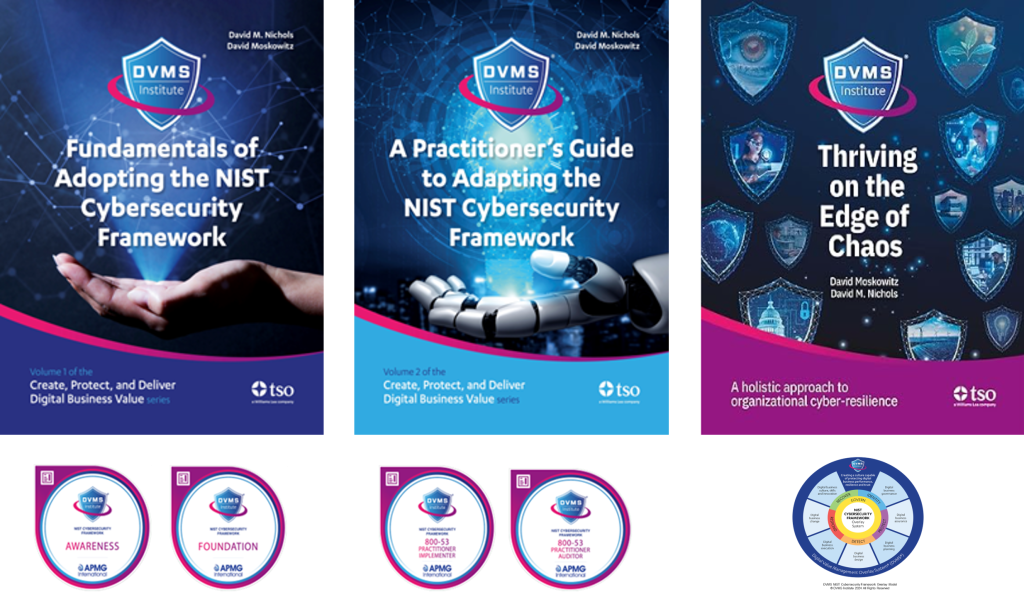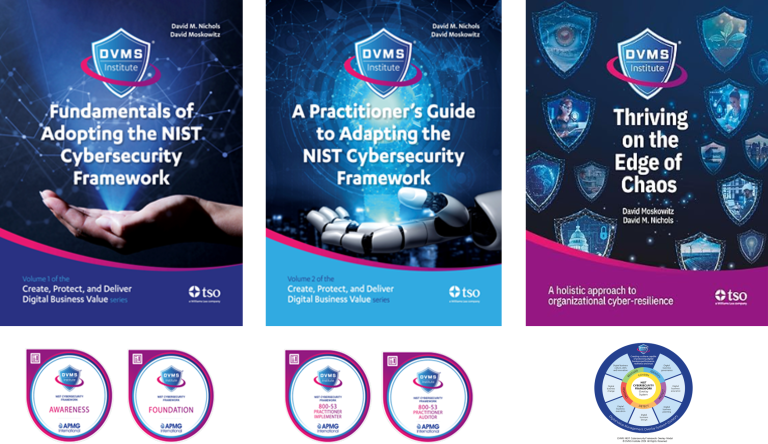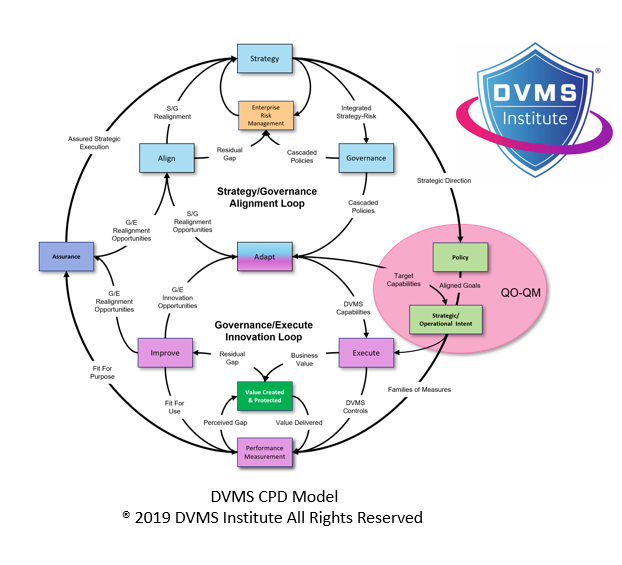The DVMS NIST Cybersecurity Framework Certification Training Programs
Rick Lemieux – Co-Founder and Chief Product Officer of the DVMS Institute
A Market Leader in NIST CSF Outcomes Training
The NIST Cybersecurity Framework (CSF) has emerged as a global standard for managing cybersecurity risk. Since its initial release in 2014 and its recent upgrade to CSF 2.0 in 2024, organizations across industries have sought effective training programs to operationalize its principles. Numerous entities now offer CSF training, from introductory awareness to advanced practitioner and implementation levels.
The DVMS certified training courses are accredited by APMG International, assured by NCSC/GCHQ in the UK, and recognized by DHS-CISA-NICCS as qualified training for the NIST NICE training.
The DVMS Institute distinguishes itself in this crowded field through its deeply integrated, systems-thinking-based approach, which is tied explicitly to enabling Cyber Operational Governance, Resilience, and Assurance outcomes across an enterprise and its complex digital ecosystem.
This analysis contrasts DVMS Institute courses with other CSF training providers to highlight the Institute’s unique value proposition.
DVMS Institute’s Foundational Philosophy
At the heart of the DVMS Institute’s CSF curriculum lies a radically different perspective: cybersecurity is not an isolated function but a byproduct of a resilient, well-governed digital business system.
The Institute’s CSF training is grounded in a Digital Value Management System® (DVMS). This systems-based overlay views cybersecurity as an organizational quality issue embedded in culture, governance, and decision-making structures.
This pedagogical distinction is crucial. While most training programs frame cybersecurity as a technical or compliance discipline, DVMS reframes it as a strategic, cross-functional capability essential to digital value creation and protection. Their emphasis is not just on “what” the CSF prescribes, but on “how” to internalize and operationalize it as part of enterprise-level resilience engineering.
Curriculum Depth and Breadth
The DVMS Institute offers a layered learning path aligned to maturity models and the complexity of real-world implementation. Key certifications include:
- NIST-CSF Awareness: This publication and course focus on the fundamentals of digital business value and risk, its threat landscape, the NIST Cybersecurity Framework, and the employee’s role in deterring digital risk.
- Fundamentals of Adopting the NIST CSF: This publication and course focus on foundational knowledge of CSF 2.0 and introduce the DVMS as a scalable overlay to existing frameworks.
- Practitioner’s Guide to Adapting the NIST CSF: This publication and course explore applying CSF practices as a strategic, enterprise-wide cyber resilience capability powered by the DVMS CPD, ZX, 3D Knowledge models supported by a leadership team and culture dedicated to sustaining and continuously innovating organizational digital value
- Thriving on the Edge of Chaos: This publication and course apply systems thinking, complexity theory, and organizational learning to build cyber-resilient cultures that sustain and continually innovate CSF adoption.
This curriculum teaches the framework’s structure—such as Functions, Categories, Subcategories, Profiles, and Tiers—and how to implement CSF principles across diverse cultural, organizational, and operational environments. By contrast, many market alternatives focus predominantly on framework literacy (definitions, mappings, and assessments) and limit their scope to checklist-driven compliance.
Systems Thinking and the Overlay Model
Perhaps the most striking innovation in the DVMS curriculum is its use of the “overlay” concept. Rather than treating CSF as a standalone project or department initiative, the DVMS Institute trains learners to see CSF as a map to uncover performance gaps across existing frameworks, methods, and systems.
This approach is based on systems thinking principles, where the organization is treated as a complex adaptive system (CAS). The DVMS Z-X Model introduces the concept of minimum viable capabilities (Govern, Assure, Plan, Design, Change, Execute, Innovate) and ties them directly to digital value creation and protection. Unlike other CSF courses that treat functions like IDENTIFY and PROTECT as isolated silos, the DVMS courses connect them with leadership behavior, cultural evolution, and continuous learning.
Organizational Resilience and Strategic Adaptability
While most CSF training emphasizes risk reduction, DVMS courses emphasize organizational resilience and strategic adaptability. The Institute reframes risk as “strategy-risk,” blending it with business decision-making and leadership. Participants learn that cybersecurity outcomes are not merely about incident response or protection, but about shaping sustainable, resilient operations capable of learning from disruption and turning adversity into competitive advantage.
This focus on resilience is not theoretical. DVMS Institute programs draw from military, psychological, and industrial organizational sciences to craft an adaptive learning organization. These dimensions are mainly absent from other CSF courses, often grounded in compliance-heavy or control-focused frameworks like ISO 27001.
Audience and Professional Application
The DVMS certification tracks are purpose-built for interdisciplinary teams. They target not only IT and security practitioners but also practitioners in governance, risk management, service management, HR, legal, and the general business population. This is a critical difference from other CSF training providers, which often target only security professionals or risk assessors.
Moreover, the Institute’s content is designed for real-world application across sectors, scales, and maturity levels. Its practitioner’s guides provide implementation playbooks tailored to startup environments, large enterprises, and government institutions.
Market Comparisons
A comparative glance at several popular NIST CSF training providers shows marked contrasts:
- SANS Institute: This course primarily targets technical audiences and focuses on threat-based use cases, often in operational tech or incident handling scenarios.
- ISC² and ISACA: Integrate CSF in their broader certifications (e.g., CISSP, CISM), but do not offer CSF-specific programs with operational implementation depth.
- PECB: PECB offers a specialized training program titled Certified NIST Cybersecurity Consultant. This course is designed to equip professionals with the basic knowledge of NIST publications, including the NIST Cybersecurity Framework (CSF).
- Others – Many low-cost options on the internet follow the same format as those listed above
Practical Tools and Resources
DVMS Institute courses come with supporting models like:
- The DVMS Z-X Model (capability-centric overlay)
- The CPD Model (Create, Protect, Deliver)
- The Cultural Web for Organizational Change
- The 3D Knowledge Model for cross-silo team-level execution and communication
These tools are pedagogical models and practical instruments that guide implementation, team building, and risk-aware decision-making.
Additionally, DVMS offers maturity assessments, diagnostics, and community platforms to help learners benchmark their organization’s progress and connect with peer organizations.
Conclusion: A Comprehensive, Future-Ready Alternative
In today’s digitally driven economy, cyber disruptions are no longer an “if” but a “when.”
The DVMS Institute’s certified training programs teach organizations the skills to build a holistic, culture-aligned overlay system capable of coordinating adaptive, cyber operations governance, resilience, and assurance across a complex digital ecosystem.
Achieving true cyber resilience across a complex digital ecosystem requires seamless alignment between organizational Strategy, Governance, and Operations, underpinned by a culture dedicated to sustaining and continuously innovating organizational digital value.
The DVMS positions cyber resilience as a strategic, enterprise-wide capability powered by the Institute’s CPD, ZX, and 3D Knowledge models.
This systems-based approach to cyber operational resilience demands active engagement from all members of the digital ecosystem, with each member playing a distinct role in proactively identifying and mitigating the systemic risks that threaten digital business operations.
This adaptive, forward-looking approach to Governance, Resilience and Assurance positions businesses to:
- Maintain Operational Stability Amidst Constant Digital Disruption
- Drive Agility and Trust Across Your Digital Ecosystem
- Satisfy Critical Regulatory and Certification Requirements
- Leverage Cyber Resilience as a Competitive Advantage
About the Author

Rick Lemieux
Co-Founder and Chief Product Officer of the DVMS Institute
Rick has 40+ years of passion and experience creating solutions to give organizations a competitive edge in their service markets. In 2015, Rick was identified as one of the top five IT Entrepreneurs in the State of Rhode Island by the TECH 10 awards for developing innovative training and mentoring solutions for boards, senior executives, and operational stakeholders.
In today’s digitally driven economy, cyber disruptions are no longer an “if” but a “when.”
The DVMS Institute’s Certified Training Programs teach organizations the skills to build a Holistic and Culture-Aligned Overlay System capable of coordinating Adaptive, Cyber Operations Governance, Resilience, and Assurance across a Complex Digital Ecosystem.
Achieving true cyber resilience across a complex digital ecosystem requires seamless alignment between organizational Strategy, Governance, and Operations, underpinned by a culture dedicated to sustaining and continuously innovating organizational digital value.

The DVMS positions cyber resilience as a strategic, enterprise-wide capability powered by the Institute’s CPD, Z-X, and 3D Knowledge models.
This systems-based approach to cyber operational resilience demands active engagement from all members of the Digital Ecosystem, with each member playing a distinct role in proactively identifying and mitigating the systemic risks that threaten digital business operations.
This adaptive, forward-looking approach to Governance, Resilience, and Assurance (GRA) positions businesses to:
- Maintain Operational Stability Amidst Constant Digital Disruption
- Drive Agility and Trust Across Your Digital Ecosystem
- Satisfy Critical Regulatory and Certification Requirements
- Leverage Cyber Resilience as a Competitive Advantage
DVMS Explainer Videos
- Architecture Video: David Moskowitz explains the DVMS System
- Case Study Video: Dr. Joseph Baugh Shares His DVMS Story.
- Overlay Model – What is an Overlay Model
- ZX Model – The MVC’s that power operational resilience
- CPD Model – Adaptable governance and assurance
- 3D Knowledge Model – Enabling holistic organizational learning
- FastTrack Model – A phased approach to cyber resilience
Digital Value Management System® is a registered trademark of the DVMS Institute LLC.
® DVMS Institute 2025 All Rights Reserved




